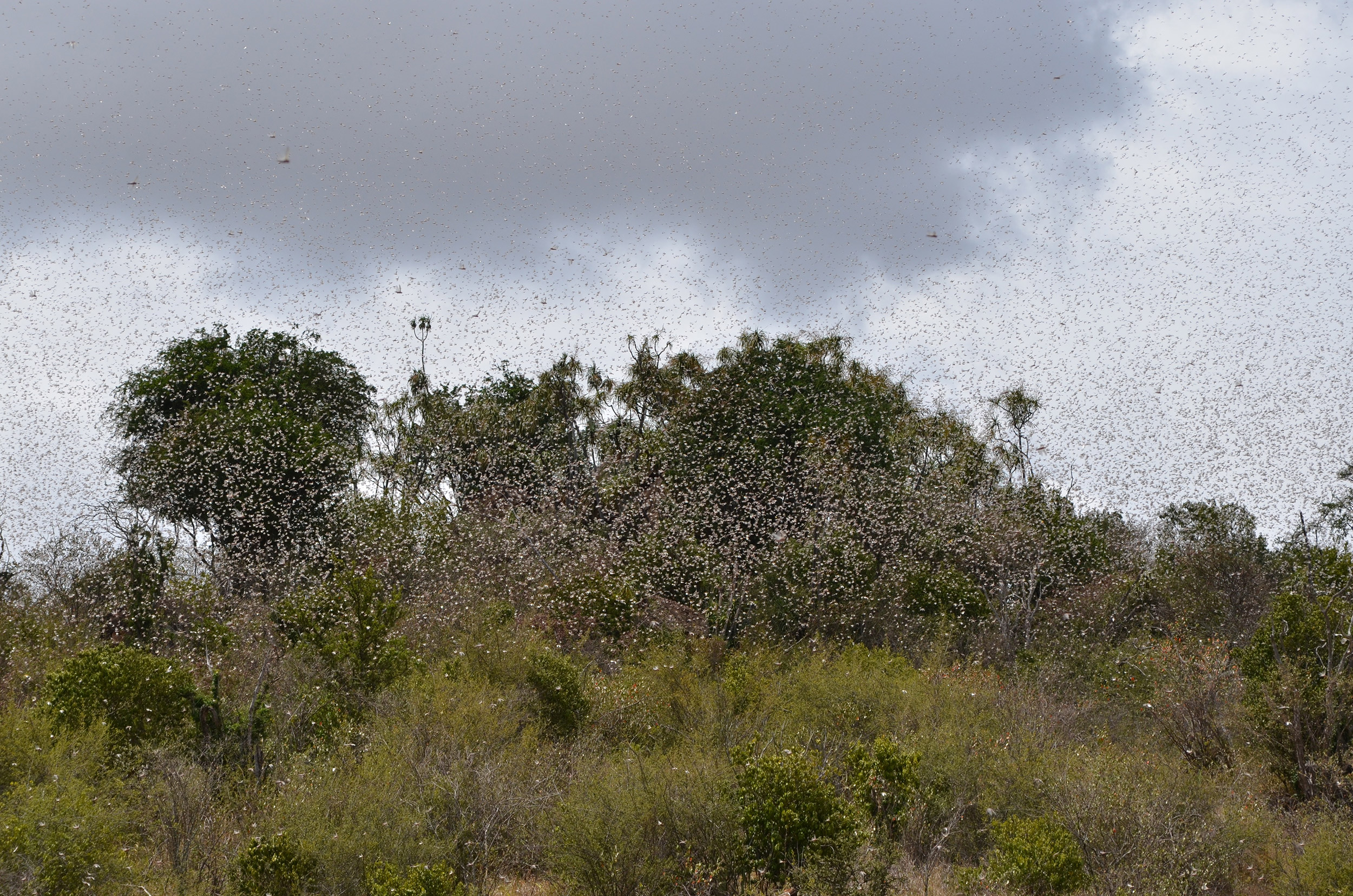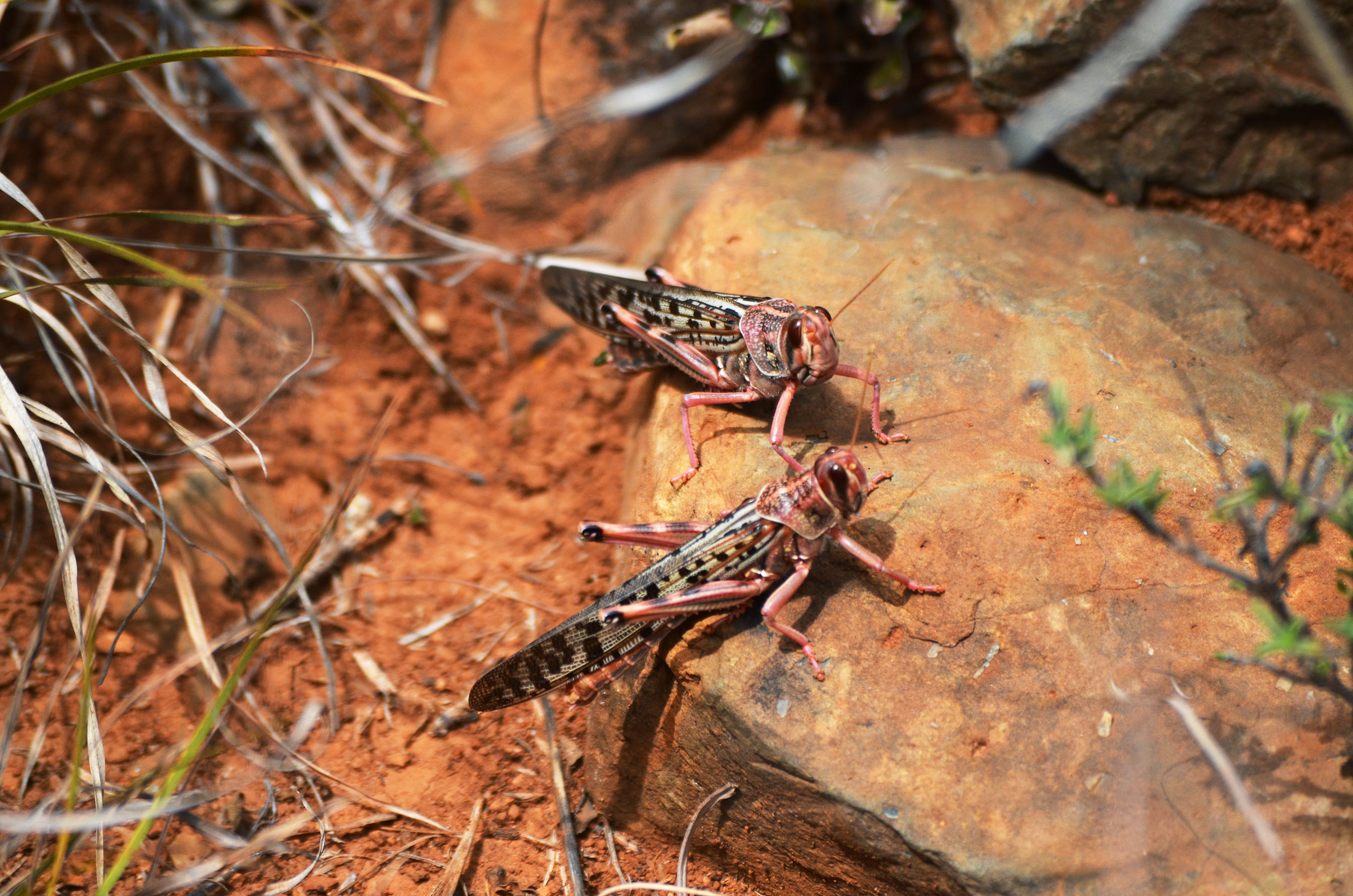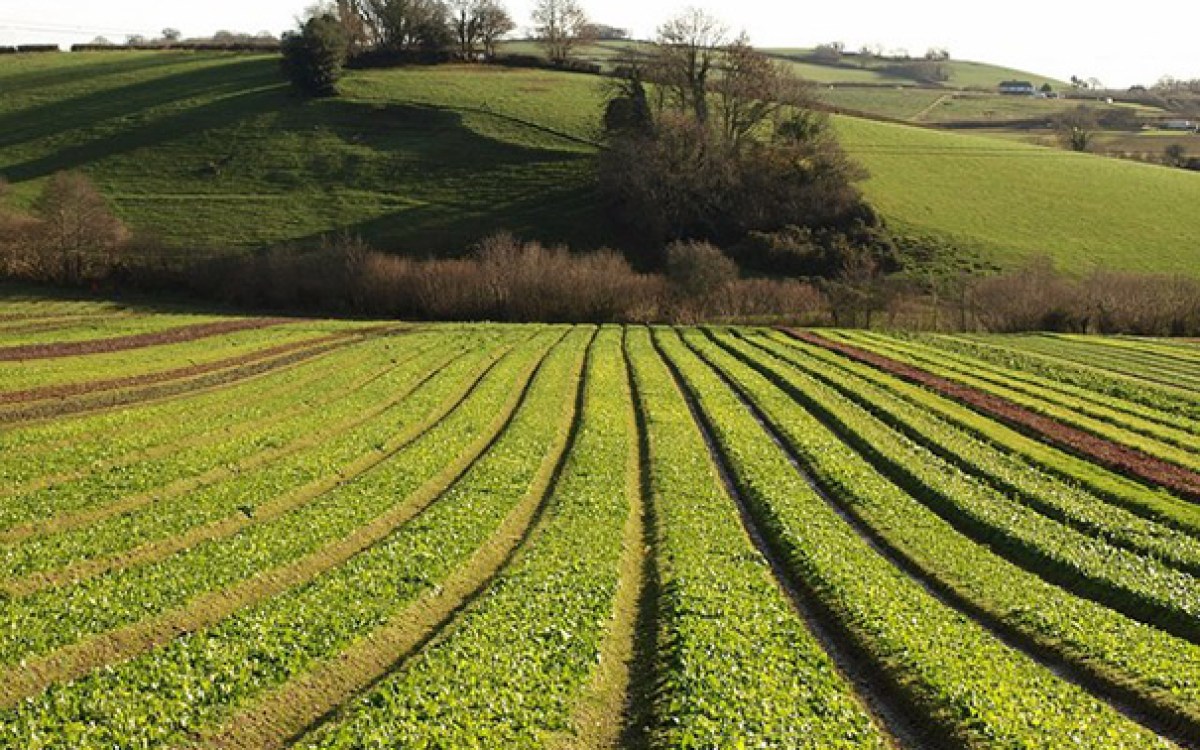Video: Justin Saglio/Harvard Staff
East Africa facing massive swarms of locusts
Researcher looks to sequence the pest’s genome as part of push to find a safer alternative to dangerous pesticides
A plague of locusts has descended on East Africa, devouring crops, trees, and pasture as they move. The first generation, which emerged at the end of last year, numbered in the hundreds of billions. Left unchecked, locusts multiply by a factor of 20 per generation, according to the UN Food and Agriculture Organization (FAO), meaning that the second generation that took flight in March and April numbered in the trillions. Now in July, a third generation is set to take off, paving the way for potentially calamitous food shortages in Kenya, Ethiopia, and Somalia. Swarms can cover many square miles (sometimes areas as big as cities), move up to 100 miles a day, and eat their weight daily. Recently swarms have also emerged in India and Pakistan. Dino Martins is an entomologist, evolutionary biologist, and executive director of the Mpala Research Centre in northern Kenya, which is working to sequence the locust genome. Martins ’11 is a former doctoral researcher in the Naomi Pierce Lab in Harvard’s Department of Organismic and Evolutionary Biology. The Gazette spoke to him about the current situation in East Africa, focusing on his native Kenya, where he currently lives.
Q&A
Dino Martins
GAZETTE: Are swarms like this a regular occurrence in the region?
MARTINS: The locusts are a really interesting phenomenon. We haven’t seen swarms of desert locusts in this part of the world for a long period of time. In fact, the last big swarms that we know of were in Kenya about 70 years ago, so it has come as a surprise to many people. It’s extremely alarming because of the devastation they can bring if left unchecked, especially to agricultural production.
The first swarm appeared in Kenya on Dec. 30 and then they very, very quickly spread through the country. The reason for that is the wind patterns were helping them. What’s happening now is the winds have turned again. The southeast monsoons are blowing from the Indian Ocean onto Kenya and so the winds are blowing from the south and they’re carrying the locust swarms. Even though locusts can move large distances, they make use of the wind. They can’t fly against it very well, so the locusts are moving with the wind from where they were in the more central parts of Kenya further north into the border regions, with Somalia, Ethiopia, and South Sudan. We expect that to continue for a few months, but they have laid eggs, and the eggs are hatching, and they are breeding, leading to what’s believed to be potential third generation of locusts.
Right now, there are bands of hoppers or nymphs — these are locusts in their immature stages — that are being observed in parts of northern Kenya and because the conditions are good, and there are rains going into the Horn of Africa, they will breed in other areas. Now, the question is: Will they be able to breed up enough to form even larger swarms? They might do that, and they might not. Right now, the prediction is that they will continue breeding and continue potentially increase in number.
That’s really worrying because large parts of Kenya have very lush, fertile agricultural areas. We have in Kenya this amazing geography of hot-dry areas and then these highlands, which is where most of the population lives and most of our food is produced. Not just for Kenya either. We export food to lots of other parts of the world. Most of the places the locusts have bred right now are not agricultural. They’re either pastoral or have just been natural, wild areas that don’t have a lot of activity other than grazing by livestock and whatnot. The real concern is if they move south when the wind changes again and the locusts do move in large numbers into much higher agriculturally productive areas.
GAZETTE: What happens then?
MARTINS: It could be devastating if the swarms move into those areas. We will see bigger swarms affecting food security and moving through the landscape.

A swarm of locusts surrounds vegetation.
Photos by Anne Powys
Overall the impact, so far at least, in Kenya has been fairly modest for now, but that doesn’t mean locally it hasn’t been dramatic. Locusts can eat their own weight each day. Grasshoppers and locusts, that’s really what they do, is they sit around and they eat. They can be voracious feeders. As an example, imagine a swarm of a million locusts. Say the weight of these locusts amounts to five million grams, which is like five tons of locusts. If they’re eating their weight every day that’s five tons of vegetation a day.
Luckily, there is so much vegetation built across most of these areas that they’ve been in, that the feeding on vegetation hasn’t been as harmful or as damaging as it could have been. But when they land on some of these farms then the impact is very big because, obviously, if you’re growing a crop and it gets eaten up, that’s a big deal. That’s a livelihood possibly ruined.
GAZETTE: How big are these swarms?
MARTINS: Swarms can vary a lot in size. They could be anywhere from the size of a football field to covering many, many square miles. It is really a remarkable phenomenon when you get to swarms of that size. Historically, one of the largest swarms ever recorded was in Kenya, which covered 10,000 square kilometers. People who were alive back then tell these amazing stories of the sky going dark. At the beginning of this a few months ago, we were seeing some big swarms that were covering a few square miles.
GAZETTE: About how many locusts are in those swarms?
MARTINS: Trillions. In fact, trillions may even be a conservative figure because there’s no real way of measuring them across some of these landscapes. The air is just filled with them. They land on all the vegetation. When you’re in a swarm, especially if it’s just as they’re getting moving, it’s actually quite an incredible experience. You see, they change color when they’re young — they’re more pinkish and then as they mature they become yellow — so when they are flying around you at that stage, you have all these pink and yellow wings whirring around and a slightly nutty smell of the locusts surrounding you and lots of birds feeding on them.
Locusts travel using the wind. When they land, they eat their bodyweight in food.

GAZETTE: It sounds like you’re speaking from experience?
MARTINS: I saw them when they came through Mpala a couple of months ago, and I went out and looked at some of the other swarms that passed nearby because this has not happened for so long. From a biologist perspective, this has been an amazing experience to go and see the power of an insect. We normally think of insects as things that we can step on. In this case, these insects are so many that you can really see where their power comes from. We talk about insects running the world. That’s totally true when you see a swarm of locusts.
GAZETTE: How do swarms get to this size? Tell us a bit about them.
MARTINS: Locusts are a creature that have been around for a long time, and they’re very much associated with the deserts of Central Asia, the Middle East, and the Horn of Africa region. Most of the time, these locusts just hang out in these areas, and they live normal lives. Occasionally, the conditions align that allow them to undergo this remarkable transformation from a solitary, nondescript creature into this amazing swarm with totally different sorts of behaviors, abilities to move over large distances, feed in in large numbers, and breed in large numbers.
Basically, what happens is when the breeding conditions improve, they start laying more and more eggs in the sand. They like wet, sandy soil. What happened over the last few months leading up to the first swarms in December and at the beginning of this year was that we had an extraordinary amount of rainfall. Even in what was supposed to be our dry season, we were getting a lot of rain. So, all of these dry, arid areas, desert areas, and semi-desert areas were switched from totally dusty to being full of vegetation and grass so the locusts had a lot of places to lay eggs.
Those eggs hatch and as the numbers increase, the density of them together, and the physical contact of them all together triggers an epigenetic switch that actually changes them from solitary animals to this gregarious creature. There’re all sorts of other cues that are involved, as well, but now the numbers start building up. Let’s say, for instance, you have 2,000 locusts. One thousand are males and 1,000 are females. If 1,000 females lay eggs and each female lays 100 eggs then that continues, then very quickly you end up with millions and billions and trillions.
GAZETTE: What have been some of the responses to control these swarms?
MARTINS: There are really only two forms of control. One is aerial spraying using planes or helicopters, but it’s very challenging logistically. These areas are huge, and the locusts could be breeding in places that people haven’t noticed because they aren’t as inhabited. The locusts are also moving into South Sudan and other parts of the Horn of Africa, which are politically unstable, so it’s very hard to go in there and do any control measures or even monitor. Another other option is to spray the hoppers. They can’t fly yet and they get sprayed either by hand or from vehicles or some other form. But as the number goes up, the more unfeasible it is.
“We normally think of insects as things that we can step on. In this case, these insects are so many that you can really see where their power comes from.”
There’s also the natural response. My sense is that there are also a lot of natural things that are catching up with the locusts, whether that be predators, parasites, and things like that. It’s not like they just have a free-for-all; they do get eaten by birds and many other creatures as well. When they came through Mpala, for instance, I saw migrating European storks — the white storks — feeding on the locusts as they came through. That’d been one of the reasons I’ve been saying let’s spray more sensibly. If we do it badly, we could end up killing all this other biodiversity.
GAZETTE: Tell us a bit about your own work with locusts?
MARTINS: We’re working with a team of scientists from the Smithsonian, the U.S. Department of Agriculture, and many others to see if we can sequence the locust genome. It’s never been fully sequenced. One remarkable thing about the locusts is they appear to have a very large genome. It’s more than double the size of the human genome, which is pretty amazing for an insect. There are many different aspects of locusts the genome could help us understand. We could get a better understanding of some of the physiology and biology. For example, it could help us understand the switch that occurs in them from being solitary to gregarious. There’s lots and lots of questions like that.
My real interest in looking at the locusts is how are they part of the wider ecology and landscape and that question of how we respond to them. Right now, we use pesticides and chemicals to respond, as I said. We have to do that because there aren’t many other options, but I do have concerns about the chemicals being used. We want to come up with better ways of containing them using a bio-pesticide of pheromones or other substances, which has been very successful in a number of insect pests. That would all be informed by having a good genome available.
GAZETTE: Has the pandemic hampered the response?
MARTINS: It really is a double-edged, in fact, a triple-edged sword right now for many communities that don’t have a lot of resources, governments that are very stressed, and with the lack of ability to move around. The locusts control groups have been given some exemptions, so they are continuing with their responses despite the restrictions on movement. The government is aware that needs to continue.
GAZETTE: Is there any long-term solution for these swarms?
MARTINS: I see the locust swarms as a message from nature. As terrifying and as dramatic as they are, there is a deeper message, and the message is that we are changing the environment. There’s no question about this, whether it’s through local environmental degradation, overgrazing, deforestation, or the expansion of deserts. You see, deserts are growing, and degraded land is growing across Africa. It’s huge for many different reasons, but the reasons I listed can combine to create ideal conditions for more and more locusts to breed. Climate change is a big factor because weather patterns change can bring much more rain, for instance. And who gets to win at that game? Well, the locusts. If we don’t address the deeper bigger issues, we are going to face even bigger problems.
This interview was edited for clarity and length.








